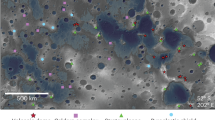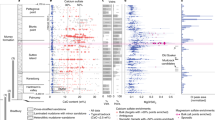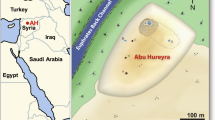Abstract
The Mars Global Surveyor's Thermal Emission Spectrometer has identified two global spectral surface types in martian dark regions, which were initially interpreted as being of basaltic (type 1) and intermediate (type 2, basaltic andesite to andesite) volcanic composition1. Wyatt and McSween2 suggest that northern-hemisphere occurrences of the type-2 spectrum are instead representative of weathered basalt, on the basis of ambiguity in the spectral interpretation and overlap between the distribution of this material and the outline of a putative ancient ocean. Although the spectral data may be open to interpretation within the limits of current understanding, creating weathered basalt and explaining its distribution is problematic. These competing hypotheses have significantly different implications for the igneous and aqueous history of Mars, and it is important to continue debating the merits of each.
This is a preview of subscription content, access via your institution
Access options
Subscribe to this journal
Receive 51 print issues and online access
$199.00 per year
only $3.90 per issue
Buy this article
- Purchase on Springer Link
- Instant access to full article PDF
Prices may be subject to local taxes which are calculated during checkout
Similar content being viewed by others
References
Bandfield, J. L., Hamilton, V. E. & Christensen, P. R. Science 287, 1626–1630 (2000).
Wyatt, M. B. & McSween, H. Y. Jr Nature 417, 263–266 (2002).
Christensen, P. R. & Moore, H. J. in Mars (eds Kieffer, H. H., Jakosky, B. M., Snyder, C. W. & Matthews, M. S.) 686–729 (Univ. Arizona Press, Tucson, 1992).
Bandfield, J. L., Edgett, K. S. & Christensen, P. R. J. Geophys. Res. 107, doi:10.1029/2000JE001469 (2003).
Bell, J. F. III in Mineral Spectroscopy: A Tribute to Roger G. Burns (eds Dyar, M. D., McCammon, C. & Schaefer, M. W.) 359–380 (Geochem. Soc., Houston, 1996).
Bandfield, J. L. J. Geophys. Res. 107, 10.1029/2001JE001510 (2002).
Wyatt, M. B., Hamilton, V. E., McSween, H. Y., Christensen, P. R. & Taylor, L. A., J. Geophys. Res. 106, 14711–14732 (2001).
Thompson, G. in Hydrothermal Processes at Seafloor Spreading Centers (eds Rona, P. A. et al.) 225–278 (Plenum, New York, 1983).
Foley, C. N., Economou, T. E., Dietrich, W. & Clayton, R. N. Meteor. Planet. Sci. 35, 55–56 (2000).
Marsh, B. D. Geochim. Cosmochim. Acta 66, 2211–2229 (2002).
Author information
Authors and Affiliations
Corresponding author
Rights and permissions
About this article
Cite this article
Hamilton, V., Christensen, P. & Bandfield, J. Volcanism or aqueous alteration on Mars?. Nature 421, 711–712 (2003). https://doi.org/10.1038/421711b
Issue Date:
DOI: https://doi.org/10.1038/421711b
This article is cited by
-
Development and Testing of the MarSCoDe LIBS Calibration Target in China’s Tianwen-1 Mars Mission
Space Science Reviews (2023)
Comments
By submitting a comment you agree to abide by our Terms and Community Guidelines. If you find something abusive or that does not comply with our terms or guidelines please flag it as inappropriate.



